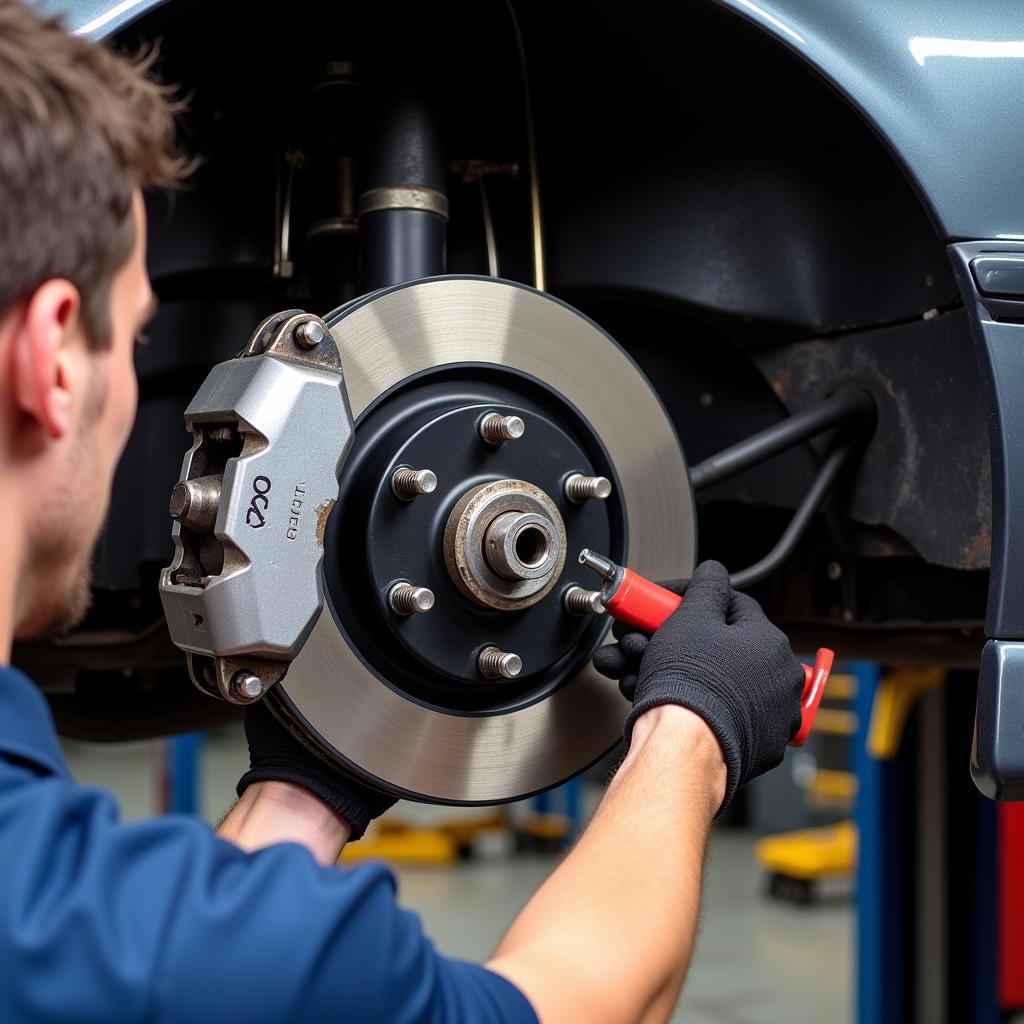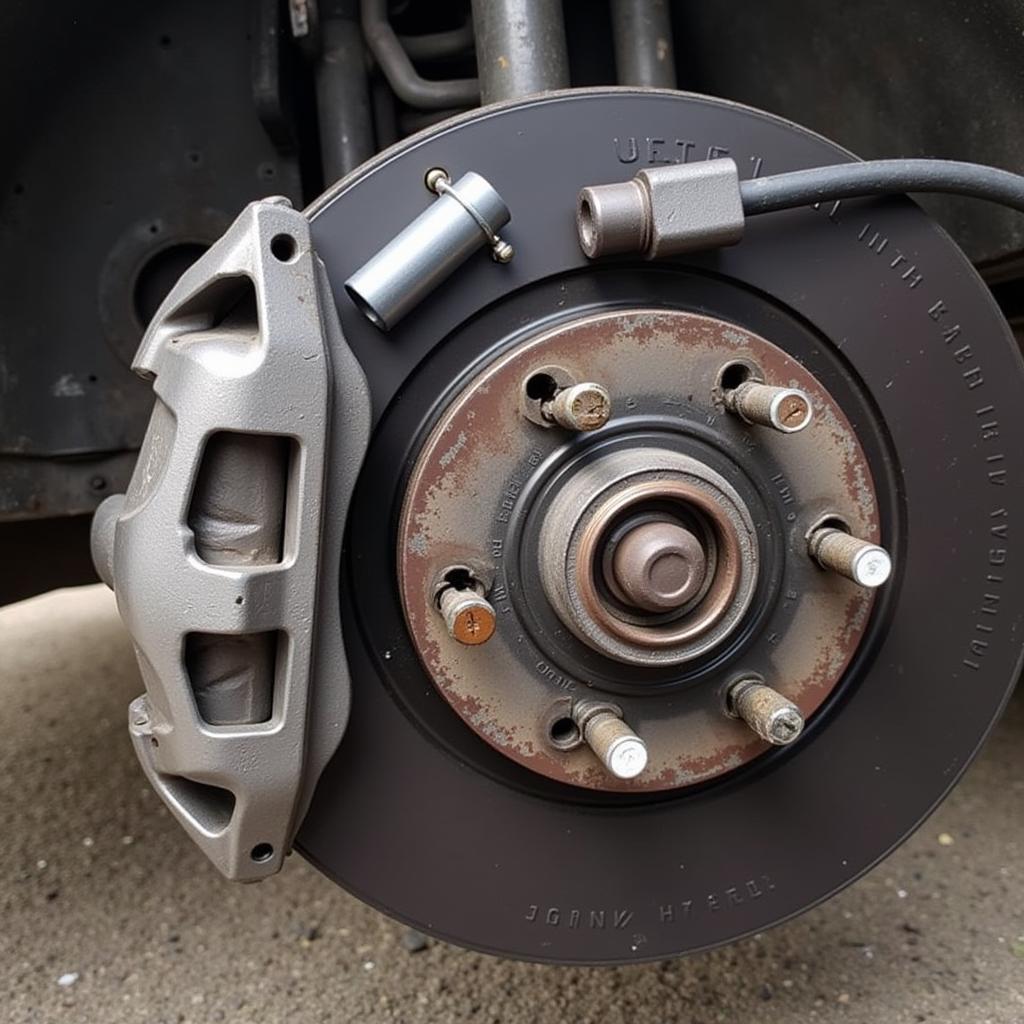The BMW E38, a masterpiece of German engineering, is renowned for its luxury and performance. However, even these automotive legends are susceptible to wear and tear. One common issue that E38 owners may encounter is the dreaded “brake lining warning” light. This article delves into the intricacies of this warning, outlining potential causes, diagnostic steps, and effective solutions to help you regain confidence in your E38’s braking system.
Understanding the Brake Lining Warning
The “brake lining warning” light, when illuminated on your E38’s dashboard, signals that the brake pad thickness on at least one wheel has fallen below a safe threshold. This typically occurs due to normal wear and tear of the brake pads over time. As you apply the brakes, friction between the pads and rotors generates stopping power, gradually wearing down the pad material. When the pad thickness reaches a critical point, the warning light triggers, urging you to take immediate action.
While worn brake pads are the most common culprit, other factors can also contribute to the warning light:
- Wworn brake pad wear sensors: E38 models are equipped with brake pad wear sensors, small wires embedded within the brake pad material. These sensors trigger the warning light upon contact with the brake rotor, indicating worn pads.
- Faulty brake pad wear sensor wiring: Over time, the wiring connected to the brake pad wear sensors can become damaged or corroded, leading to a false warning light.
- Malfunctioning instrument cluster: In rare cases, a problem with the instrument cluster itself can cause the brake lining warning light to illuminate erroneously.
Diagnosing the Brake Lining Warning
Ignoring the brake lining warning light can lead to severely compromised braking performance and potentially dangerous situations. If you encounter this warning, it’s crucial to diagnose the issue promptly. Here’s a step-by-step guide:
- Visually inspect the brake pads: Begin by safely jacking up your E38 and removing the wheel where the warning light indicates a problem. Visually inspect the brake pads through the wheel spokes or by removing the wheel for a closer look. If the pad material is visibly worn down and close to the metal backing plate, replacement is necessary.
- Check the brake pad wear sensors: If the brake pads appear to have sufficient material remaining, inspect the brake pad wear sensors. These sensors are typically small wires protruding from the brake pad on one side. Ensure the sensors are intact and not worn down. Also, check for any damage or disconnections in the sensor wiring.
- Consult a qualified mechanic: If you’re uncomfortable working on your vehicle’s braking system or are unable to identify the cause of the warning light, it’s best to consult a qualified mechanic experienced with BMW vehicles. They can accurately diagnose the issue using specialized diagnostic tools and recommend the appropriate course of action.
Addressing the Issue
Once you’ve identified the root cause of the brake lining warning light, it’s essential to address the issue promptly to restore your E38’s braking performance:
- Replacing worn brake pads and sensors: If the brake pads are worn, it’s recommended to replace them in pairs on the same axle. Additionally, replace the brake pad wear sensors on both sides of the axle to ensure accurate monitoring of pad wear.
- Repairing or replacing damaged wiring: If you discover damaged or corroded wiring connected to the brake pad wear sensors, repair or replace the affected sections with new wiring harnesses. Ensure proper grounding and secure connections to prevent future issues.
- Addressing instrument cluster malfunctions: If the diagnosis points to an instrument cluster malfunction, consult a qualified mechanic to diagnose and repair the issue. In some cases, the entire instrument cluster may require replacement.
Preventing Future Brake Lining Warnings
Preventing future occurrences of the brake lining warning light involves adopting proactive maintenance practices:
- Adhere to scheduled brake inspections: Following your BMW E38’s recommended maintenance schedule for brake inspections is crucial.
- Adopt smooth braking habits: Avoid harsh braking whenever possible, as this significantly contributes to brake pad wear.
- Address brake fluid leaks promptly: Regularly check your brake fluid level and address any leaks immediately, as low brake fluid can affect braking performance.
“Maintaining your E38’s braking system is paramount to ensuring a safe and enjoyable driving experience,” says Jake Miller, a seasoned BMW mechanic with over 20 years of experience. “By addressing the brake lining warning promptly and adopting proactive maintenance practices, you can keep your E38’s brakes in top condition and enjoy countless miles of worry-free driving.”
 BMW E38 Brake System Maintenance
BMW E38 Brake System Maintenance
Conclusion
The “brake lining warning” light on your BMW E38, while potentially alarming, is a crucial safety feature designed to alert you to potential braking system issues. By understanding the causes, following the diagnostic steps outlined, and taking prompt action to address the issue, you can ensure your E38’s braking system remains in optimal condition, providing you with peace of mind and a safe driving experience for years to come.

